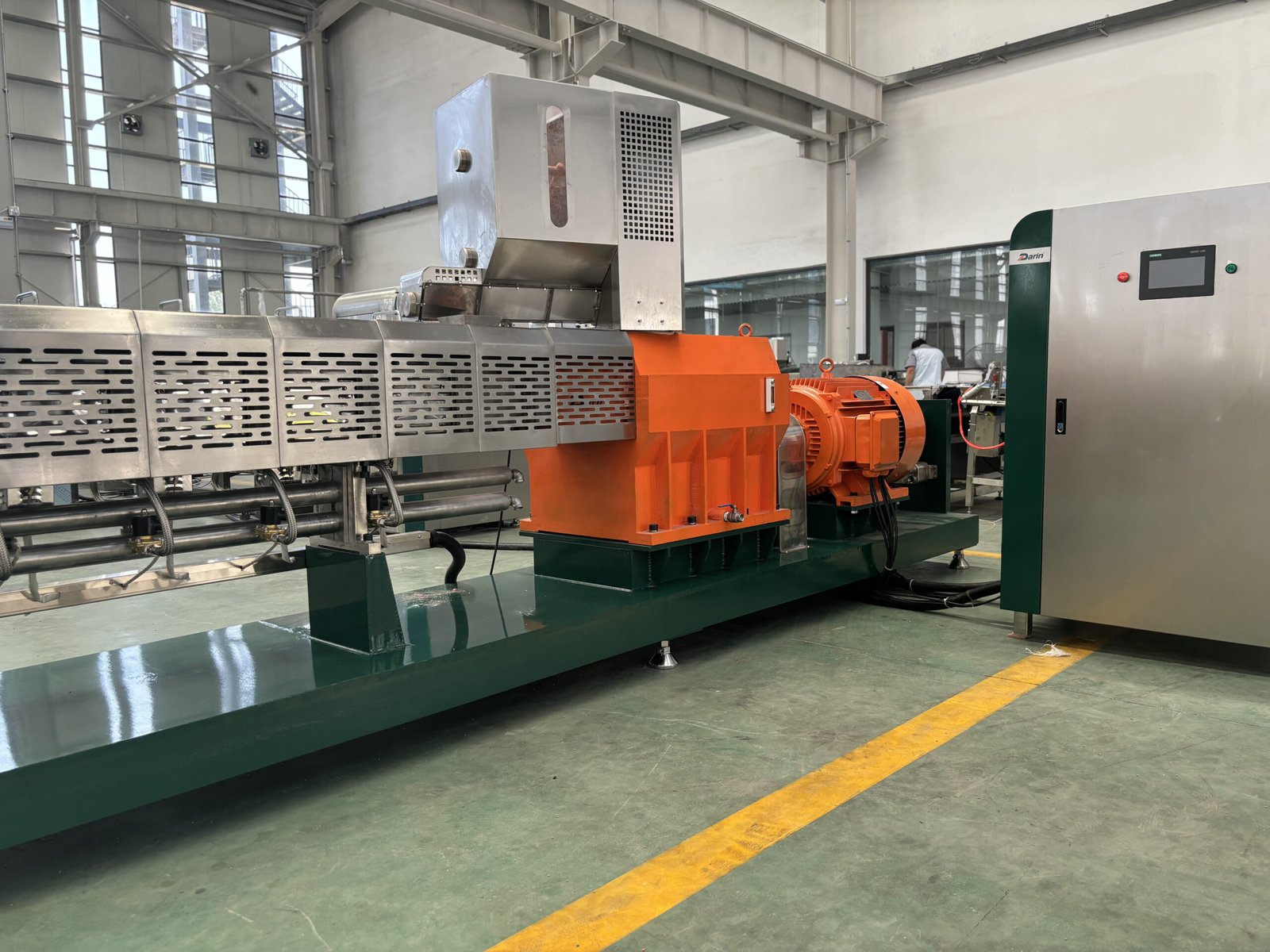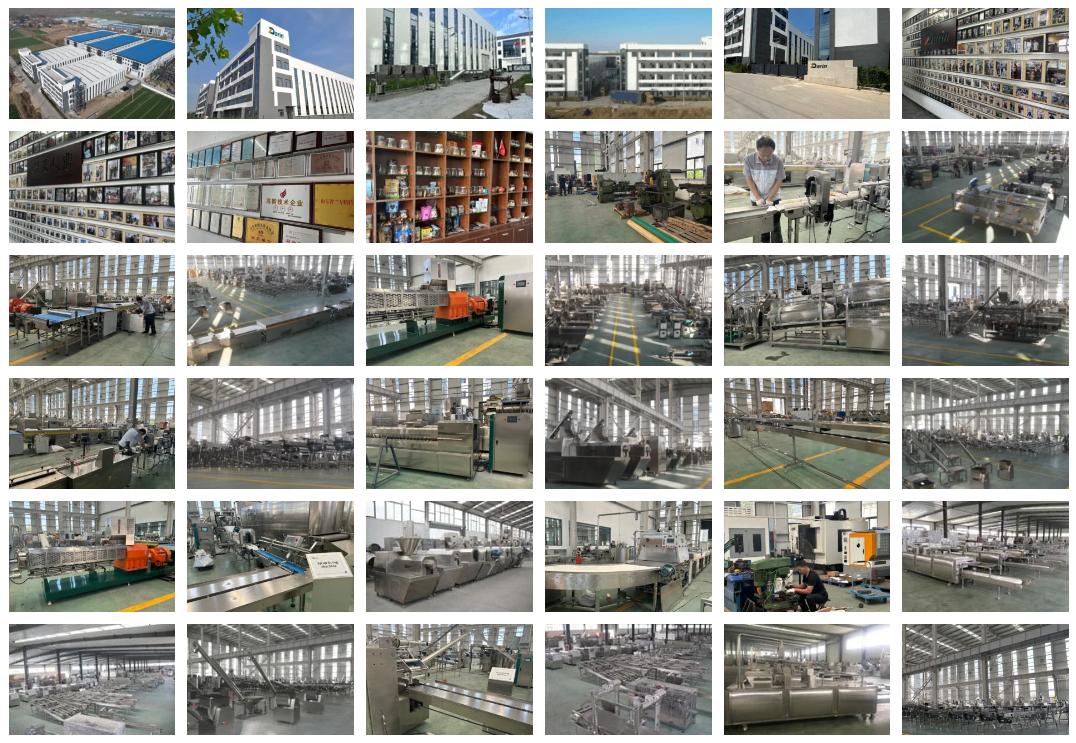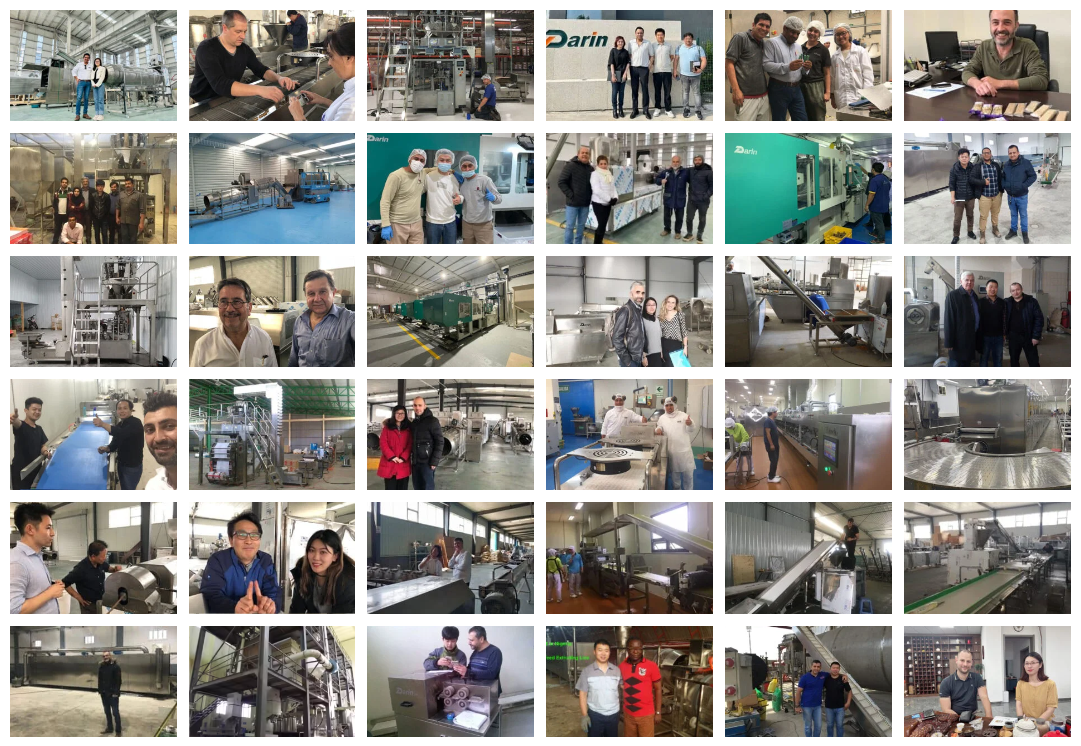 usine de Darin (4)
usine de Darin (4)
A pet food extruder may look like a single machine, but in reality, it's a highly sophisticated système modulaire with dozens of precisely controlled settings. These adjustable parameters are critical to fine-tuning production outputs—from kibble size and texture to nutrient retention and moisture levels. Manufacturers that lack control over these settings struggle with inconsistent product quality, machine downtime, and inefficiencies in raw material usage. Fortunately, today’s advanced extruders are built with multiple adjustable ranges that allow for full customization and real-time optimization. In this in-depth article, we will break down the adjustable settings on a pet food extruder, the typical control ranges for each, and how each one affects your final product.
Pet food extruders offer a broad range of adjustable settings, including screw speed (100–600 RPM), barrel temperature (40–200°C), moisture addition (10%–40%), feed rate (50–5000 kg/h), cutting speed, and die configuration. These parameters can be dynamically adjusted via PLC or SCADA systems to suit specific product types, textures, and nutritional profiles.
Being able to precisely control these settings is essential for adapting to ingredient variability, minimizing waste, and producing premium-quality pet food that meets both pet health standards and customer expectations. Let’s examine how these variables work and why they matter.
Pet food extruder settings cannot be changed during operation.Faux
Most modern extruders support real-time adjustment of settings like screw speed, temperature, and feed rate during operation, allowing for flexible, continuous production.
Full Overview of Adjustable Settings in Pet Food Extrusion
1. Vitesse de la vis (tr/min)
The screw rotation speed determines how quickly ingredients move through the barrel and how much mechanical shear is generated.
| Paramètres | Gamme | Effet |
|---|---|---|
| Vitesse de la vis | 100–600 RPM | Higher speed increases shear and internal heat; lower speed increases residence time |
Cas d'utilisation :
- Higher speeds for floating aquatic feed and puffed kibble
- Lower speeds for denser, semi-moist products
2. Barrel Temperature (Per Zone)
Each barrel segment can be heated independently to create custom thermal profiles for different recipes.
| Zone | Adjustable Range (°C) | Fonction |
|---|---|---|
| Zone d'alimentation | 40–60 | Gentle mixing |
| Zone de compression | 100–160 | Pre-cooking and shear |
| Cooking Zone | 140–200 | Full gelatinization |
| Die Zone | 150–200 | Product expansion |
Conseil :
Steam injection or electric heating systems can be set independently for each segment using a Interface PLC.
3. Moisture Addition (Steam or Water Injection)
The total taux d'humidité directly influences starch gelatinization, product expansion, and post-extrusion drying.
| Paramètres | Gamme | Objectif |
|---|---|---|
| Total Moisture Content | 10–40% | Adjusts product texture and thermal transfer efficiency |
| Steam Injection Rate | 50–500 kg/h | Preconditioning and inline heating |
| Water Injection Rate | 1–100 L/h | Fine moisture control |
Cas d'utilisation :
- High moisture (30–40%) for semi-moist diets
- Low moisture (<20%) for high-density kibble
4. Feed Rate (Dry Ingredients)
Controls how much raw material enters the system and sets the basis for throughput and product uniformity.
| Paramètres | Range (kg/h) | Effet |
|---|---|---|
| Taux d'alimentation | 50–5000 kg/h | Higher rates increase output but may require thermal adjustments |
Conseil :
Automated loss-in-weight feeders allow for highly accurate and continuous dosing.
5. Cutting Speed and Blade Configuration
Once the extrudate exits the die, it’s shaped by rotating blades. This directly impacts kibble size and surface texture.
| Paramètre | Gamme | Effet |
|---|---|---|
| Blade Speed | 50–1200 RPM | Higher speed = finer particles; lower speed = chunkier output |
| Blade Angle | Réglable | Controls edge sharpness and break pattern |
Cas d'utilisation :
Differentiate product shapes for puppy food vs. adult dog food, or hard kibble vs. treats.
6. Die Plate Configuration
Le plaque de matrice, though physical, is considered an adjustable part of the system during production runs.
| Option | Effet |
|---|---|
| Die Hole Diameter (1–15 mm) | Determines final size and shape |
| Number of Holes | Impacts pressure and backflow |
| Die Length/Thickness | Affects product density and expansion |
Many extruder systems allow quick die change mechanisms for rapid product switches.
7. Back Pressure Valve or Die Restriction
This setting controls the resistance at the end of the extruder, impacting pressure and expansion.
| Paramètres | Gamme | Fonction |
|---|---|---|
| Valve Opening | 0–100% | Closed = higher pressure, more puffing |
| Adjustable Inserts | Multiple diameters | Fine-tunes back-pressure dynamically |
8. Screw and Barrel Gap (Clearance)
In twin-screw systems, this can be adjusted to control material compression and shear energy.
| Paramètre | Gamme | Objectif |
|---|---|---|
| Inter-screw Distance | 0.1–2 mm | Alters shear and mixing intensity |
| Barrel Gap | 0.2–1.5 mm | Affects wear resistance and cooking uniformity |
9. Cooling System Settings
Post-extrusion, product is cooled using air or water to set structure and avoid microbial growth.
| Composant | Adjustable Range |
|---|---|
| Airflow Rate | 1–5 m³/min per meter of conveyor |
| Cooling Time | 1–10 minutes |
| Water Spray (for semi-moist) | 1–20 L/min |
10. Automation Parameters
Modern systems come with full digital controls allowing for:
| Fonction d'automatisation | Fonction |
|---|---|
| Recipe Memory | Store and recall preset parameters |
| SCADA Integration | Real-time monitoring and adjustment |
| Sensor Alarms | Trigger when settings exceed safe ranges |
Visual Summary: Key Adjustable Ranges in Pet Food Extruders
| Paramètre | Adjustable Range |
|---|---|
| Vitesse de la vis | 100 – 600 RPM |
| Température du canon | 40 – 200°C (per zone) |
| Humidité des aliments | 10 – 40% |
| Dry Feed Rate | 50 – 5000 kg/h |
| Blade/Cutter Speed | 50 – 1200 RPM |
| Die Hole Diameter | 1 – 15 mm |
| Die Back Pressure | 20 – 80 bar (dynamic) |
| Cooling Airflow | 1 – 5 m³/min |
Conclusion
Le range of adjustable settings on a pet food extruder provides manufacturers with extraordinary flexibility to produce a wide variety of pet food products—from dry kibble to moist treats and even aquatic feeds. By tuning parameters like vitesse de la vis, température du canon, taux d'humidité, débit d'alimentationet cutting configuration, producers can tailor products for nutritional content, shape, density, and palatability. These settings are typically controlled via automated interfaces, allowing for real-time adjustments et recipe-based production with high repeatability and low downtime.
Need Help Setting Up the Ideal Parameters?
If you want help setting up or optimizing your extrusion line’s adjustable settings, contact our engineering team today. Nous offrons :
- Custom configuration guides
- On-site and remote setup assistance
- Recipe optimization consulting
Let’s help you get the perfect product—every single batch. Reach out now!

FAQ
Q1: What adjustable settings are available on a pet food extruder?
A1: Pet food extruders offer several adjustable parameters, including screw speed (rpm), barrel temperature (°C), feed rate (kg/hr), moisture content (%), and die pressure (bar). These settings are controlled through a central control system, often with PLC automation, to fine-tune product quality and throughput.
Q2: What is the typical range for screw speed on a pet food extruder?
A2: Screw speed is commonly adjustable between 100 to 600 rpm, depending on the extruder type and the required shear intensity. Lower speeds provide gentler mixing, while higher speeds enhance mechanical energy input and throughput.
Q3: How is the feed rate adjusted, and what is its range?
A3: The feed rate, which controls the amount of raw material entering the extruder, typically ranges from 100 kg/hr to over 5,000 kg/hr. It's adjusted through variable-speed feeders and affects residence time, product consistency, and output rate.
Q4: Can moisture levels be controlled during extrusion?
A4: Yes, moisture is adjustable through water or steam injection systems and ranges between 15% to 35%, depending on the formulation. Moisture impacts texture, density, and expansion of the final pet food product.
Q5: What is the benefit of having a wide range of adjustable settings?
A5: A broad adjustment range allows operators to optimize the extrusion process for different formulations, textures, and product types. It ensures product consistency, improves digestibility, and enables quick switching between product recipes with minimal downtime.

Références
- Pet Food Extrusion Control Systems - https://www.extru-techinc.com/extrusion-control - Extru-Tech Inc.
- Twin-Screw Extrusion Technology - https://www.clextral.com/twin-screw-technology/ - Clextral
- Feed Rate and Process Control in Extrusion - https://www.feedstrategy.com - Stratégie d'alimentation
- Moisture and Temperature Management in Extrusion - https://www.sciencedirect.com/topics/agricultural-and-biological-sciences/extrusion -ScienceDirect
- Bühler Extruder Parameter Ranges - https://www.buhlergroup.com/global/en/products/twin-screw-extruders.htm - Groupe Bühler
- Optimizing Pet Food Production Settings - https://www.petfoodindustry.com - Industrie des aliments pour animaux de compagnie
 Exposition Darin[/caption]
Exposition Darin[/caption]









